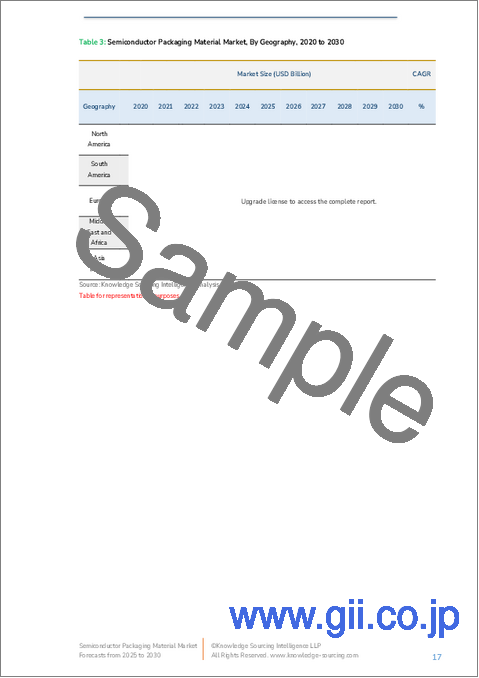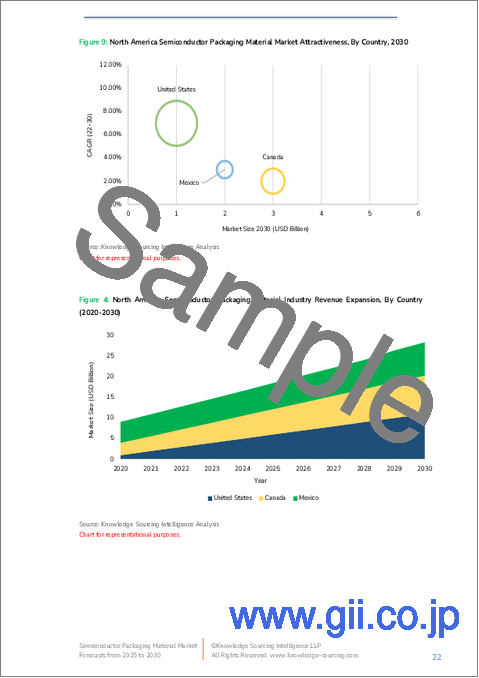|
|
市場調査レポート
商品コード
1775336
半導体パッケージング材料市場 - 2025年から2030年までの予測Semiconductor Packaging Material Market - Forecasts from 2025 to 2030 |
||||||
カスタマイズ可能
|
|||||||
| 半導体パッケージング材料市場 - 2025年から2030年までの予測 |
|
出版日: 2025年06月23日
発行: Knowledge Sourcing Intelligence
ページ情報: 英文 141 Pages
納期: 即日から翌営業日
|
全表示
- 概要
- 目次
半導体パッケージング材料市場は、CAGR 5.20%で2025年の224億7,600万米ドルから2030年には289億5,300万米ドルに成長すると予測されています。
半導体パッケージング材料は、集積回路(IC)や半導体を腐食や環境損傷から保護し、安定したチップ接続を確保するために不可欠です。これらの材料は、自動車、航空宇宙、エレクトロニクス、製造、ヘルスケアなどの産業で不可欠であり、生産プロセスの重要な構成要素となっています。本サマリーでは、2024年以降の市場開拓に基づき、半導体パッケージング材料市場の動向、促進要因、抑制要因に焦点を当て、業界専門家向けに作成しました。
市場動向
半導体パッケージング材料市場は、世界の半導体産業と密接な関係にあります。製造業、自動車、関連分野への多額の投資に後押しされた急速な産業化が、市場成長の主な要因となっています。モノのインターネット(IoT)、機械学習、人工知能(AI)などの技術が浸透しつつあることは、市場開拓に大きな影響を与えると予想されます。スマートフォン、ノートパソコン、電気自動車(EV)などの電子ガジェットの需要拡大は、半導体市場の拡大と直結しており、パッケージング材料分野にプラスの影響を与えています。
アジア太平洋地域は、主要産業が集中していること、人件費が安いこと、電子機器需要が高まっていること、技術進歩が続いていることから、市場を独占すると予測されています。しかし、世界の半導体チップ不足や原材料費の高騰などの課題に直面しており、今後の成長の妨げになる可能性があります。
主な市場促進要因
1.自動化と産業投資の増加
IoT、自動化、AI、クラウドベースのソフトウェアの普及により、世界の産業投資は急増しています。これらの技術は、自動車、航空宇宙、電子機器などの産業に不可欠な半導体チップに大きく依存しています。耐久性があり高性能なチップの需要には、信頼性と寿命を確保するための先進パッケージング材料が必要です。
この動向を示す重要な指標は、世界のロボット密度の上昇です。ロボット密度とは、産業労働者1万人当たりの稼働ロボット数で定義されます。国際ロボット連盟によると、製造業における平均ロボット密度は、従業員1万人当たり126台に達し、過去最高を記録しました。ロボットは外部データを処理するために半導体に依存しており、自動化が進むにつれて、半導体パッケージング材料の需要は大幅に増加すると予想されます。パッケージング材料は、ロボットシステムに使用されるチップの耐久性と機能性を支えるために不可欠であるため、この動向は市場の前向きな見通しを強調しています。
2.電子機器の普及拡大
経済成長により世界中で可処分所得が増加し、スマートフォン、ノートパソコン、その他の家電製品などの電子機器の需要が高まっています。これらの機器は半導体チップに大きく依存しているため、環境破壊から半導体チップを守る堅牢なパッケージング材料が必要とされています。電気自動車やハイブリッド車の普及は、この動向の顕著な例です。EVには、バッテリー管理、ソフトウェアシステム、さまざまな機能性のための半導体が必要であり、そのすべてが腐食のない信頼性の高いものでなければならないです。EVの普及が進むにつれて、半導体パッケージング材料市場は大きく拡大する立場にあります。
市場抑制要因
1.世界の半導体チップ不足
現在進行中の世界の半導体チップ不足は、パッケージング材料市場にとって依然として大きな課題です。高い需要と限られた供給の不均衡は、パンデミックによる混乱によって悪化し、エレクトロニクスとオートメーション産業を緊張させています。チップ生産の減少はパッケージング材料の需要に直接影響し、市場成長のボトルネックとなっています。回復に向けた努力が進められているもの、チップ不足は当面、半導体パッケージング材料市場にリスクをもたらし続けます。
2.原材料コストの上昇
原材料費の高騰も大きな足かせとなっています。銅価格の高騰、輸送コストの上昇、半導体不足の進行といった要因が、パッケージング材料の生産コスト上昇に寄与しています。こうしたコスト圧力は、利益率を低下させ、メーカーの財務的負担を増大させることで、市場の成長を制限する可能性があります。こうした課題に対処するには、戦略的なサプライチェーン管理とコスト最適化の努力が必要です。
本レポートの主な利点
- 洞察に満ちた分析:顧客セグメント、政府政策と社会経済要因、消費者嗜好、産業別、その他のサブセグメントに焦点を当て、主要地域および新興地域を網羅した詳細な市場考察を得ることができます。
- 競合情勢:世界の主要企業が採用する戦略的戦略を理解し、適切な戦略による市場浸透の可能性を理解することができます。
- 市場動向と促進要因:ダイナミックな要因と極めて重要な市場動向、そしてそれらが今後の市場開拓をどのように形成していくかを探ります。
- 行動可能な提言:洞察力を戦略的意思決定に活用し、ダイナミックな環境の中で新たなビジネスストリームと収益を発掘します。
- 幅広い利用者に対応:新興企業、研究機関、コンサルタント、中小企業、大企業にとって有益で費用対効果の高いです。
どのような用途で利用されていますか?
業界および市場考察、事業機会評価、製品需要予測、市場参入戦略、地理的拡大、設備投資の決定、規制の枠組みと影響、新製品開拓、競合の影響
調査範囲
- 2022年から2024年までの過去データおよび2025年から2030年までの予測データ
- 成長機会、課題、サプライチェーンの展望、規制の枠組み、および動向分析
- 競争相手のポジショニング、戦略、および市場シェア分析
- 収益の成長と予測国々を含むセグメントと地域の分析
企業プロファイル(戦略、製品、財務情報、主な開発など)
目次
第1章 イントロダクション
- 市場の定義
- 市場セグメンテーション
第2章 調査手法
- 調査データ
- 前提条件
第3章 エグゼクティブサマリー
- 調査ハイライト
第4章 市場力学
- 市場促進要因
- 市場抑制要因
- ポーターのファイブフォース分析
- 供給企業の交渉力
- 買い手の交渉力
- 新規参入業者の脅威
- 代替品の脅威
- 業界内の競争企業間の敵対関係
- 業界バリューチェーン分析
第5章 半導体パッケージング材料市場:タイプ別分析
- イントロダクション
- 有機基質
- ボンディングワイヤ
- リードフレーム
- セラミックパッケージ
- ダイアタッチ材
- その他
第6章 半導体パッケージング材料市場:業界別分析
- イントロダクション
- 家電
- 自動車
- ヘルスケア
- IT・通信
- 航空宇宙および防衛
- その他
第7章 半導体パッケージング材料市場:テクノロジー別分析
- イントロダクション
- グリッド配列
- スモールアウトラインパッケージ
- クアッドフラットパッケージ
- デュアルフラットノーリード
- シングルインラインパッケージ
- デュアルインラインパッケージ
- その他
第8章 半導体パッケージング材料市場:地域別分析
- イントロダクション
- 北米
- 米国
- カナダ
- メキシコ
- 南米
- ブラジル
- アルゼンチン
- その他
- 欧州
- 英国
- ドイツ
- フランス
- その他
- 中東・アフリカ
- アラブ首長国連邦
- 南アフリカ
- イスラエル
- サウジアラビア
- その他
- アジア太平洋地域
- 中国
- 日本
- インド
- オーストラリア
- 台湾
- 韓国
- その他
第9章 競合環境と分析
- 主要企業と戦略分析
- 新興企業と市場収益性
- 合併、買収、合意およびコラボレーション
- ベンダー競争力マトリックス
第10章 企業プロファイル
- Dow Inc.
- Henkel AG & Co. KGaA
- Sumitomo Chemical Co., Ltd.
- BASF SE
- Hitachi Chemical Co., Ltd.
- DuPont de Nemours, Inc.
- Samsung Electro-Mechanics Co., Ltd.
- Shin-Etsu Chemical Co., Ltd.
- LG Chem Ltd.
- Jiangsu ChangJian Technology Co., Ltd.
The semiconductor packaging material market is expected to grow from USD 22.476 billion in 2025 to USD 28.953 billion in 2030, at a CAGR of 5.20%.
Semiconductor packaging materials are critical for protecting integrated circuits (ICs) and semiconductors from corrosion and environmental damage, ensuring stable chip connections. These materials are essential across industries such as automotive, aerospace, electronics, manufacturing, and healthcare, forming a vital component of the production process. This summary focuses on market trends, driving factors, and restraints for the semiconductor packaging material market, based on developments from 2024 onward, tailored for industry experts.
Market Trends
The semiconductor packaging material market is closely tied to the global semiconductor industry. Rapid industrialization, fueled by significant investments in manufacturing, automotive, and related sectors, is a primary driver of market growth. The increasing penetration of technologies such as the Internet of Things (IoT), machine learning, and artificial intelligence (AI) is expected to significantly influence market development. The growing demand for electronic gadgets, including smartphones, laptops, and electric vehicles (EVs), directly correlates with the semiconductor market's expansion, positively impacting the packaging material sector.
The Asia-Pacific region is projected to dominate the market due to its concentration of key industries, low labor costs, rising demand for electronics, and ongoing technological advancements. However, the market faces challenges, including a global shortage of semiconductor chips and rising raw material costs, which could hinder growth in the coming years.
Key Market Drivers
1. Rising Automation and Industrial Investment
Global industrial investment is surging, driven by widespread adoption of IoT, automation, AI, and cloud-based software. These technologies rely heavily on semiconductor chips, which are integral to industries like automotive, aerospace, and electronics. The demand for durable, high-performance chips necessitates advanced packaging materials to ensure reliability and longevity.
A key indicator of this trend is the global rise in robot density, defined as the number of operational robots per 10,000 industrial workers. According to the International Federation of Robotics, the average robot density in manufacturing reached a record 126 units per 10,000 employees. Robots depend on semiconductors for processing external data, and as automation continues to grow, the demand for semiconductor packaging materials is expected to increase significantly. This trend underscores the market's positive outlook, as packaging materials are critical for supporting the durability and functionality of chips used in robotic systems.
2. Growing Adoption of Electronic Gadgets
Economic growth has boosted disposable incomes worldwide, leading to higher demand for electronic gadgets such as smartphones, laptops, and other consumer electronics. These devices rely heavily on semiconductor chips, driving the need for robust packaging materials to protect them from environmental damage. The rise in electric and hybrid vehicle adoption is a notable example of this trend. EVs require semiconductors for battery management, software systems, and various functionalities, all of which must be corrosion-free and reliable. As EV adoption grows, the semiconductor packaging material market is well-positioned for significant expansion.
Market Restraints
1. Global Semiconductor Chip Shortage
The ongoing global shortage of semiconductor chips remains a significant challenge for the packaging material market. The imbalance between high demand and limited supply, exacerbated by disruptions from the pandemic, has strained the electronics and automation industries. Reduced chip production directly impacts the demand for packaging materials, creating a bottleneck for market growth. Although recovery efforts are underway, the chip shortage continues to pose a risk to the semiconductor packaging material market in the near term.
2. Rising Raw Material Costs
The increasing cost of raw materials presents another major restraint. Factors such as rising copper prices, elevated shipping costs, and the ongoing semiconductor shortage contribute to higher production costs for packaging materials. These cost pressures could limit market growth by reducing profit margins and increasing the financial burden on manufacturers. Addressing these challenges will require strategic supply chain management and cost-optimization efforts.
Key Benefits of this Report:
- Insightful Analysis: Gain detailed market insights covering major as well as emerging geographical regions, focusing on customer segments, government policies and socio-economic factors, consumer preferences, industry verticals, and other sub-segments.
- Competitive Landscape: Understand the strategic maneuvers employed by key players globally to understand possible market penetration with the correct strategy.
- Market Drivers & Future Trends: Explore the dynamic factors and pivotal market trends and how they will shape future market developments.
- Actionable Recommendations: Utilize the insights to exercise strategic decisions to uncover new business streams and revenues in a dynamic environment.
- Caters to a Wide Audience: Beneficial and cost-effective for startups, research institutions, consultants, SMEs, and large enterprises.
What do businesses use our reports for?
Industry and Market Insights, Opportunity Assessment, Product Demand Forecasting, Market Entry Strategy, Geographical Expansion, Capital Investment Decisions, Regulatory Framework & Implications, New Product Development, Competitive Intelligence
Report Coverage:
- Historical data from 2022 to 2024 & forecast data from 2025 to 2030
- Growth Opportunities, Challenges, Supply Chain Outlook, Regulatory Framework, and Trend Analysis
- Competitive Positioning, Strategies, and Market Share Analysis
- Revenue Growth and Forecast Assessment of segments and regions including countries
Company Profiling (Strategies, Products, Financial Information, and Key Developments among others.
By Type
- Organic Substrates
- Bonding Wires
- Lead-frames
- Ceramic Package
- Die Attach Material
- Others
By Industry Vertical
- Consumer Electronics
- Automotive
- Healthcare
- IT & Telecommunication
- Aerospace and Defense
- Others
By Technology
- Grid Array
- Small Outline Package
- Quad Flat Package
- Dual-flat no-leads
- Single In-Line Package
- Dual In-Line Package
- Others
By Geography
- North America
- USA
- Canada
- Mexico
- South America
- Brazil
- Argentina
- Others
- Europe
- U.K.
- Germany
- France
- Others
- Middle East and Africa
- UAE
- South Africa
- Israel
- Saudi Arabia
- Others
- Asia-Pacific
- China
- Japan
- India
- Australia
- Taiwan
- South Korea
- Others
TABLE OF CONTENTS
1. INTRODUCTION
- 1.1. Market Definition
- 1.2. Market Segmentation
2. RESEARCH METHODOLOGY
- 2.1. Research Data
- 2.2. Assumptions
3. EXECUTIVE SUMMARY
- 3.1. Research Highlights
4. MARKET DYNAMICS
- 4.1. Market Drivers
- 4.2. Market Restraints
- 4.3. Porters Five Forces Analysis
- 4.3.1. Bargaining Power of Suppliers
- 4.3.2. Bargaining Power of Buyers
- 4.3.3. The Threat of New Entrants
- 4.3.4. Threat of Substitutes
- 4.3.5. Competitive Rivalry in the Industry
- 4.4. Industry Value Chain Analysis
5. SEMICONDUCTOR PACKAGING MATERIAL MARKET ANALYSIS, BY TYPE
- 5.1. Introduction
- 5.2. Organic Substrates
- 5.3. Bonding Wires
- 5.4. Lead-frames
- 5.5. Ceramic Package
- 5.6. Die Attach Material
- 5.7. Others
6. SEMICONDUCTOR PACKAGING MATERIAL MARKET ANALYSIS, BY INDUSTRY VERTICAL
- 6.1. Introduction
- 6.2. Consumer Electronics
- 6.3. Automotive
- 6.4. Healthcare
- 6.5. IT & Telecommunication
- 6.6. Aerospace and Defense
- 6.7. Others
7. SEMICONDUCTOR PACKAGING MATERIAL MARKET ANALYSIS, BY TECHNOLOGY
- 7.1. Introduction
- 7.2. Grid Array
- 7.3. Small Outline Package
- 7.4. Quad Flat Package
- 7.5. Dual-flat no-leads
- 7.6. Single In-Line Package
- 7.7. Dual In-Line Package
- 7.8. Others
8. SEMICONDUCTOR PACKAGING MATERIAL MARKET ANALYSIS, BY GEOGRAPHY
- 8.1. Introduction
- 8.2. North America
- 8.2.1. USA
- 8.2.2. Canada
- 8.2.3. Mexico
- 8.3. South America
- 8.3.1. Brazil
- 8.3.2. Argentina
- 8.3.3. Others
- 8.4. Europe
- 8.4.1. U.K.
- 8.4.2. Germany
- 8.4.3. France
- 8.4.4. Others
- 8.5. Middle East and Africa
- 8.5.1. UAE
- 8.5.2. South Africa
- 8.5.3. Israel
- 8.5.4. Saudi Arabia
- 8.5.5. Others
- 8.6. Asia Pacific
- 8.6.1. China
- 8.6.2. Japan
- 8.6.3. India
- 8.6.4. Australia
- 8.6.5. Taiwan
- 8.6.6. South Korea
- 8.6.7. Others
9. COMPETITIVE ENVIRONMENT AND ANALYSIS
- 9.1. Major Players and Strategy Analysis
- 9.2. Emerging Players and Market Lucrativeness
- 9.3. Mergers, Acquisitions, Agreements, and Collaborations
- 9.4. Vendor Competitiveness Matrix
10. COMPANY PROFILES
- 10.1. Dow Inc.
- 10.2. Henkel AG & Co. KGaA
- 10.3. Sumitomo Chemical Co., Ltd.
- 10.4. BASF SE
- 10.5. Hitachi Chemical Co., Ltd.
- 10.6. DuPont de Nemours, Inc.
- 10.7. Samsung Electro-Mechanics Co., Ltd.
- 10.8. Shin-Etsu Chemical Co., Ltd.
- 10.9. LG Chem Ltd.
- 10.10. Jiangsu ChangJian Technology Co., Ltd.





